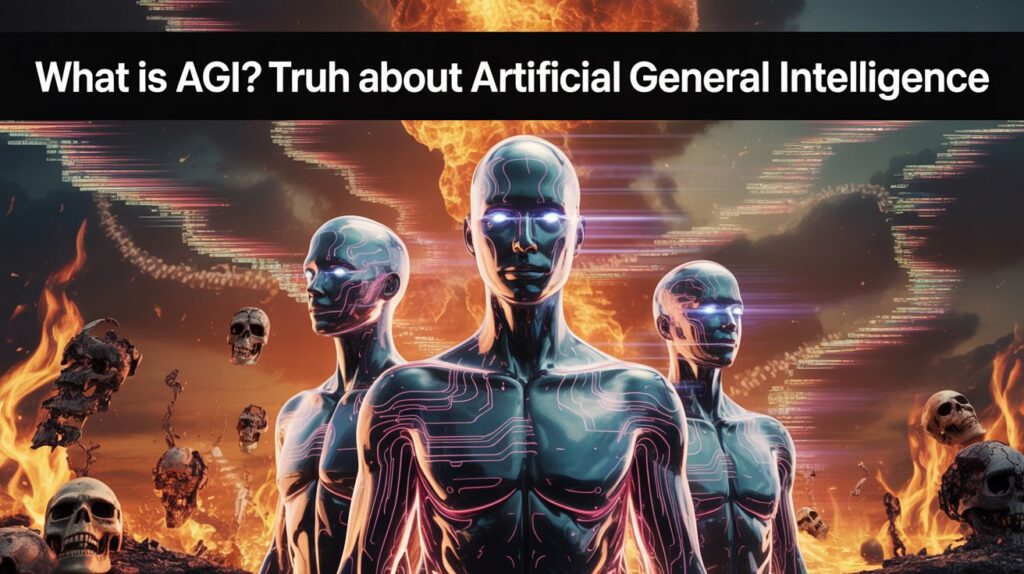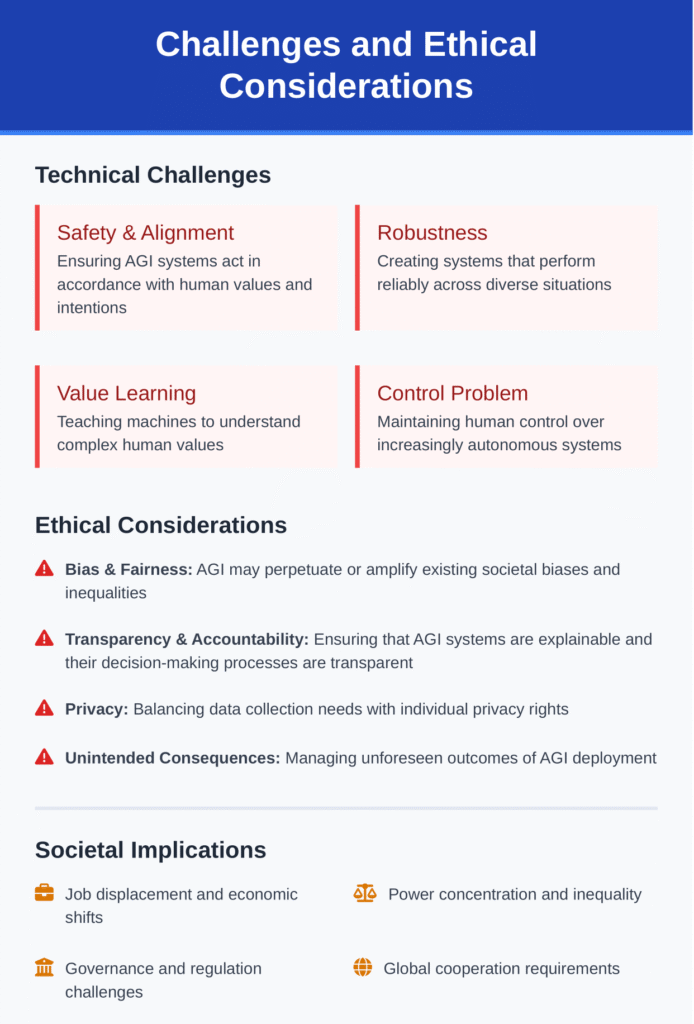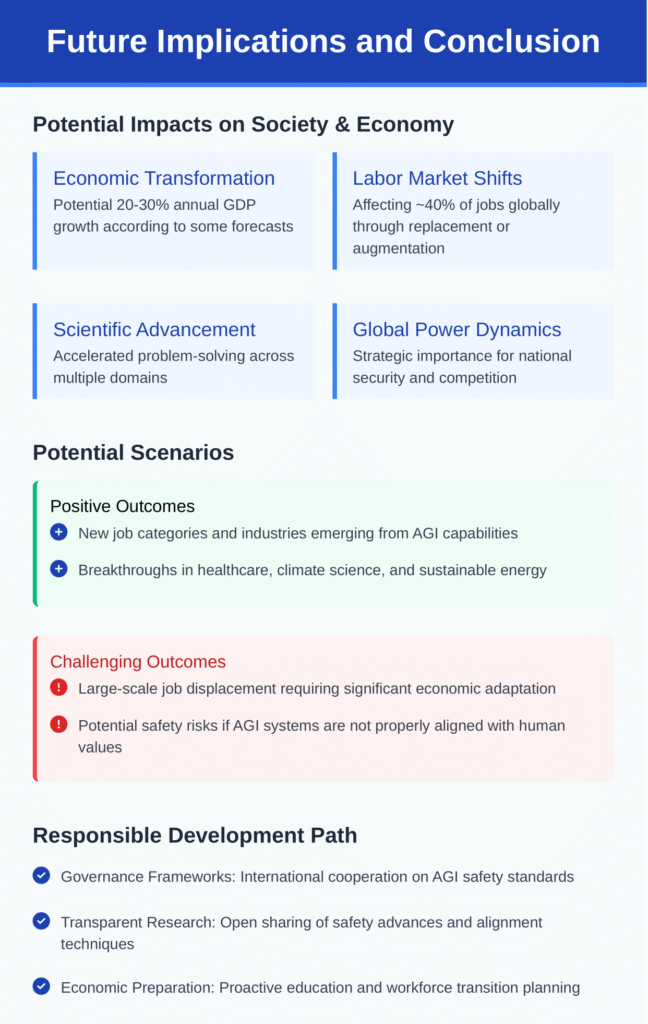Ever wondered if machines could actually think like humans do?

Picture a world when computers not only understand your commands but can learn new abilities on their own, demonstrate creativity, solve complicated issues, and even develop emotional intelligence. That’s the promise—and possible peril—of Artificial General Intelligence (AGI). While today’s AI can defeat chess grandmasters and create beautiful artwork, it still falls short of actual human-like intelligence. But the race toward AGI is accelerating at a stunning rate, with tech titans investing billions and scholars disputing whether we’re years or decades away from this revolutionary breakthrough.
What Is AGI (Artificial General Intelligence)?
Artificial General Intelligence (AGI) refers to a potential type of AI that would match or exceed human capabilities across practically all cognitive tasks. Unlike the specialized AI systems we employ today—which are trained to perform specific jobs like image recognition, language translation, or game playing—AGI would contain a broad, flexible intelligence similar to human cognition. Think of it as the difference between a calculator that answers arithmetic problems versus a human mathematician who can build entirely new theories, instruct students, publish books, and modify their expertise to address unanticipated issues.
It would demonstrate similar adaptability.
The term “Artificial General Intelligence” was popularized in 2002 by AI researchers Shane Legg and Ben Goertzel, however the concept has been essential to AI research since its earliest days. Other words commonly used interchangeably include “strong AI,” “human-level AI,” and “general intelligent action,” however each bears slightly different philosophical connotations.
AGI vs. Narrow AI vs. Artificial Superintelligence
To comprehend it properly, we need to put it within the broader spectrum of artificial intelligence capabilities→
Narrow AI (ANI)→ Where We Are Today
- Voice assistants like Siri and Alexa
- Image recognition systems in smartphones
- Chess algorithms like Deep Blue
- Self-driving car navigation systems
- Recommendation algorithms for streaming platforms
While amazing in their domains, these systems cannot transfer their learning to various tasks. Your chess software can’t suddenly help diagnose medical issues, and your voice assistant can’t learn to drive a car without considerable reprogramming.
Artificial General Intelligence→ The Next Frontier
AGI represents a quantum leap beyond narrow AI. This system would possess→
- The ability to learn any intellectual work that a human can
- Transfer learning between different domains
- General problem-solving ability
- Understanding of abstract concepts
- Adaptive reasoning across unexpected settings
Most crucially, it would have what AI researchers call “generality”—the potential to apply intellect broadly rather than within restricted bounds.
Artificial Superintelligence (ASI)→ Beyond Human Capability

Key Characteristics of AGI
What capabilities would a true AGI system need to demonstrate? While definitions differ across studies, certain key qualities are frequently identified→
Versatility and Adaptability
As researchers at GeeksforGeeks explain, “AGI transcends the limitations of narrow AI by excelling at multiple tasks, from playing chess and composing music to conducting scientific research and interpreting human emotions. It mirrors the diverse intellectual abilities of humans.”
Self-Improvement and Learning
Perhaps the most striking aspect of AGI would be its ability to learn continuously and better itself. Current AI systems require human engineers to update and modify them, while it would be capable of independent development and knowledge acquisition.
This self-improvement capability makes it particularly interesting—and potentially concerning.
An AGI system might theoretically begin a loop of recursive self-improvement, leading to rapidly accelerating capabilities.
Common Sense Reasoning
Current AI systems lack true comprehension of basic physical principles, social dynamics, and causal relationships that humans intuitively perceive. It would need to learn this form of thinking to function well in real-world contexts.
Creativity and Problem-Solving
Human intelligence isn’t simply about processing information—it’s about developing unique insights and innovative solutions. It would need to display actual creativity, inventing new ways to problems rather than simply optimizing current methods.
This could involve scientific discovery, creative expression, or inventive problem-solving in disciplines like engineering or medicine.
Natural Language Understanding
The Path to AGI→ Historical Perspective
The pursuit for producing machine intelligence has a rich history spanning decades, with the concept of it’s important to AI research from its early days.
The Birth of AI (1950s-1960s)
These early pioneers were remarkably hopeful.
The AI Winters (1970s-1980s)
This led to what’s known as the first “AI winter”—a time of reduced funding and interest in AI research. A similar cycle occurred in the late 1980s when Japan’s ambitious Fifth Generation Computer Project failed to accomplish its AGI-oriented aims.
The Rise of Applied AI (1990s-2000s)
Deep Learning Revolution (2010s-Present)
The field altered substantially with the emergence of deep learning and neural networks. In 2012, a neural network named AlexNet displayed breakthrough performance in image recognition, spurring increased interest in AI capabilities.
Current State of AGI Research
Major Players in AGI Development
Several groups stand at the forefront of AGI research→
- OpenAI→ Founded with the specific purpose of generating safe AGI, OpenAI has built increasingly powerful models like GPT-4, which some academics think displays early hints of AGI-like capabilities.
- Google DeepMind→ Combining DeepMind’s reinforcement learning skills with Google’s resources, DeepMind focuses on building AI with general problem-solving ability.
- Anthropic→ Founded by former OpenAI researchers, Anthropic is exploring “Constitutional AI” approaches that aim to construct AI systems that are both powerful and aligned with human ideals.
- Meta AI→ Meta (previously Facebook) has invested extensively in AI research, including constructing big language models and researching multimodal AI systems.
- xAI→ Elon Musk’s new AI startup is developing advanced models like Grok 4, which according to some accounts displays considerable gains in reasoning ability.
Recent Breakthroughs
Several recent advances have accelerated progress toward AGI-like capabilities→
- Large Language Models (LLMs)→ Models like GPT-4 and Claude have showed extraordinary language abilities, including complex reasoning, coding, and cross-domain knowledge.
- Multimodal AI→ Systems that can handle various sorts of data—text, graphics, audio, video—are displaying more integrated comprehension of information.
- Reasoning-First Approaches→ Models like OpenAI’s o1 reveal a new paradigm where AI systems “think before they respond,” improving problem-solving capabilities.
- Self-Supervised Learning→ Modern AI systems can learn from enormous volumes of unlabeled data, extracting patterns without human assistance.
- Reinforcement Learning from Human Feedback (RLHF)→ This technique allows AI models to learn from human preferences, helping align their outputs with human expectations.
Emerging Research Directions
Several interesting research directions may help to AGI development→
- Brain-Inspired Computing→ Some academics are building neural network topologies that more closely imitate the organization of the human brain.
- Embodied AI→ This approach emphasizes the necessity of bodily engagement with the world for developing intelligence.
- Hybrid Systems→ Combining neural networks with symbolic reasoning systems may generate more resilient general intelligence.
- Open-Ended Learning→ Creating systems that can continuously learn and innovate without specified goals, comparable to biological evolution.
Tests for Confirming Human-Level AGI
How would we know when we’ve attained AGI? Researchers have offered different benchmarks and tests→
The Turing Test
Recent testing reveals that advanced models like GPT-4 can be identified as human around 54% of the time in Turing Tests—approaching but not yet matching human performance (67%).
The Robot College Student Test
The Employment Test
AI researcher Nils Nilsson proposed that AGI should be able to execute economically valuable jobs at least as effectively as humans. This practical benchmark focuses on real-world value rather than abstract intelligence.
The Coffee Test
Apple co-founder Steve Wozniak recommended that an AGI should be able to enter an average American home, discover the coffee machine, locate coffee and water, and effectively prepare coffee. This test emphasizes the importance of combining reasoning, perception, and physical manipulation in unfamiliar environments.
The Modern Turing Test

Challenges in Developing AGI
Despite great advances in AI capabilities, several key barriers exist between present systems and real AGI→
Common Sense Reasoning
Perhaps the most enduring difficulty is constructing AI systems that understand the world as people do—with intuitive understanding about physics, social dynamics, and causal links that doesn’t require explicit programming.
Transfer Learning
Developing more flexible transfer learning capacities is key for generating fully adaptable intelligence.
Interpretability and Explainability
Physical Embodiment
Some researchers claim that actual intellect requires physical connection with the world. While disembodied language models demonstrate excellent cognitive capacities, they lack the grounded understanding that comes from traversing actual reality.
Consciousness and Self-Awareness
Potential Benefits and Applications: Impact of AGI
If AGI becomes reality, its potential uses could change practically every element of human society→
Scientific Discovery
It might substantially accelerate scientific progress, analyzing large datasets to uncover patterns undetectable to human researchers. From drug development to materials research, it could assist address challenges that have withstood human attempts for decades.
Imagine an AGI studying thousands of potential molecular compounds to uncover new antibiotics or inventing novel materials with finely tailored features for sustainable energy production.
Healthcare Revolution
As Ilya Sutskever, co-founder of OpenAI, explained in his TED talk→ “If we had an AGI system working in healthcare, it would have complete and comprehensive knowledge of all medical literature. It would have billions of hours of clinical experience and would be available always and at very low cost.”
Education Transformation
Economic Productivity
Solving Global Challenges
Perhaps most crucially, it could help humanity solve existential concerns like climate change, pandemic prevention, and sustainable resource management. By analyzing complex systems and modeling potential interventions, it could identify solutions that might escape human analysis.
Ethical Implications and Risks
The emergence of AGI involves important ethical problems that academics, governments, and society must cope with→
Job Displacement
It could possibly automate a wide range of cognitive jobs currently performed by humans. Unlike previous waves of automation that mostly affected physical labor, it might influence knowledge workers including programmers, surgeons, attorneys, and creative professionals.
Security Risks
Alignment Problem
Perhaps the most fundamental difficulty is ensuring that this systems adopt goals and values associated with human wellbeing. This “alignment problem” is essential to AGI safety research—how do we assure that massively powerful systems operate in ways beneficial to humanity?
Concentration of Power
Existential Risk
Some academics suggest that sufficiently sophisticated AGI could potentially represent an existential risk to mankind if its goals stray from human welfare. This problem has inspired extensive research into AGI safety and ethics.

Is AGI Already Here? → The Ongoing Debate
One of the most contested problems in AI research today is whether present systems are nearing or even attaining early versions of it→
The Case for Early AGI
Some academics think that today’s most advanced models already display significant AGI-like capabilities→
The Case Against Current AGI
Other academics remain unconvinced, pointing to basic shortcomings in present systems→
Gary Marcus, a renowned AI skeptic, observes that current systems still make basic reasoning errors, lack full knowledge of cause and effect, and can’t consistently accomplish complex multi-step tasks.
Redefining Intelligence
This discussion underscores fundamental questions about how we define intelligence itself. Is intelligence primarily about language processing and pattern recognition? Does it involve bodily interaction with the physical world? Must it contain consciousness or subjective experience?
Timeline Predictions→ When Will AGI Arrive?
When might we anticipate AGI to become reality? Expert perspectives differ dramatically→
Expert Surveys
Surveys of AI researchers have showed diminishing timelines for AGI arrival→
A 2024 poll by Grace et al. of 2,778 AI researchers indicated that respondents expected a 50% possibility of computers exceeding humans in every task by 2047—13 years earlier than predicted in a similar study only one year before.
This acceleration in expectations reflects the rapid growth of AI capabilities in recent years, notably with big language models and multimodal systems.
Optimistic Predictions
Some major experts in AI research expect relatively near-term timelines→
- Demis Hassabis (Google DeepMind)→ In 2023, said AGI may appear within “a decade or even a few years.”
- Jensen Huang (NVIDIA CEO)→ In 2024, forecasted that within five years, AI would pass any test at least as well as humans.
- Leopold Aschenbrenner (former OpenAI researcher)→ In 2024, assessed AGI by 2027 to be “strikingly plausible.”
- Geoffrey Hinton (AI pioneer)→ In 2024, projected 5-20 years before systems smarter than humans.
Skeptical Perspectives
Others are more wary regarding AGI timelines→
- Paul Allen (Microsoft co-founder)→ Before his death, stated that it would require “unforeseeable and fundamentally unpredictable breakthroughs” improbable in the 21st century.
- Alan Winfield (roboticist)→ Compared the distance between present AI and AGI to the difference between current space flight and faster-than-light travel.
- Gary Marcus (AI researcher)→ Consistently emphasizes that existing techniques confront fundamental constraints that will require important conceptual breakthroughs.
The Difficulty of Prediction

Preparing for an AGI Future
Regardless of exact dates, the possible development of AGI necessitates serious preparation→
Research Priorities
Several research areas will be crucial for ensuring beneficial AGI development→
- AI Safety→ Developing technical techniques to ensure AGI systems remain aligned with human values and purposes.
- AI Governance→ Creating institutional structures and rules for responsible AGI development and deployment.
- Human-AI Collaboration→ Exploring how people and increasingly sophisticated AI systems may work together most effectively.
- Economic Transition→ Understanding and preparing for economic changes that it might trigger.
International Cooperation
Individual Preparation
Even as corporations and governments prepare for AGI, individuals can take efforts to adapt to an increasingly AI-driven future→
- Developing talents that complement rather than compete with AI capabilities
- Understanding the foundations of AI to engage effectively with these technologies
- Participating in conversations regarding how AI should be managed and deployed
Maintaining Perspective
Conclusion
Artificial General Intelligence offers both the initial concept that launched the study of AI and its most ambitious frontier. While today’s AI systems demonstrate extraordinary capabilities in some domains, real AGI would constitute a fundamental leap forward—a sort of machine intelligence with the diverse problem-solving abilities that define human cognition.
The path to AGI entails deep technical obstacles, from common sense thinking to transfer learning to congruence with human values. Yet progress continues to speed, with each breakthrough bringing us closer to this transformative technology.
Whether it arrives in years or decades, its potential influence deserves serious attention now. By seriously addressing the technological, ethical, and societal consequences of increasingly general artificial intelligence, we can endeavor to guarantee that these powerful technologies improve human flourishing rather than harming it. The truth about Artificial General Intelligence is that it represents both our greatest technological desire and our most profound responsibility—to develop robots that not just think like us but think with us, increasing human potential while reflecting our deepest beliefs.
What are your thoughts on AGI? Do you feel we’re approaching this technical milestone, or do considerable difficulties remain? Share your perspective in the comments below.
1. What is AGI vs AI?
AI (Artificial Intelligence) refers to machines developed to do certain tasks like image recognition, translation, or conversation. AGI (Artificial General Intelligence) is a potential kind of AI that can accomplish every intellectual work a person can, with reasoning, learning, and adaptation across disciplines.
2. Is ChatGPT AGI or AI?
ChatGPT is AI, not AGI. It’s a sophisticated language model taught to generate human-like prose, but it doesn’t understand or think like people across all circumstances.
3. What does AGI mean?
AGI stands for Artificial broad Intelligence, which refers to robots that possess broad human-level cognitive abilities, including thinking, problem-solving, and learning across any task.
4. What does AGI mean for ChatGPT?
If ChatGPT were AGI, it would perceive context like a human, learn new skills on the fly, and think critically. Currently, it’s a specialized AI, not real AGI.
5. Is ChatGPT 4.0 AGI?
No, GPT-4 is not AGI. It’s a powerful AI model with outstanding linguistic skills, but it lacks deep comprehension, emotion, and general reasoning like a person.
6. What is the entire form of AGI in AI?
The complete form is Artificial General Intelligence — AI that’s capable of comprehending, learning, and completing any intellectual work a person can do.
7. Is Grok 4 AGI?
Nope. Grok 4 by xAI is still a sort of narrow AI, just like ChatGPT. It’s powerful in discussion but not capable of actual universal intelligence.
8. Is there any AI that is AGI?
As of today, no AI has attained AGI. All existing systems (ChatGPT, Grok, Gemini, Claude, etc.) are narrow AI–they excel in specialized tasks but lack true general intelligence.